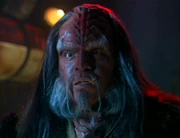
Human Jonathan Archer, infected by the Klingon augment virus (2154)
The cranial ridges, also referred to as exocranial ridges or cranial plates are bony plates on the surface of the forehead on many humanoid species. Some species, such as Humans, Vulcans, and the ancient humanoids do not possess visible cranial ridges.
Klingon-Human hybrids generally inherit cranial ridges from their Klingon parent, although they are less pronounced. (VOY: "Nothing Human")
In 2154, the Klingon augment virus, and the subsequent cure, caused many Klingons to lose their cranial ridges and become more like "Humans." This would be partially cured via cranial reconstruction. (ENT: "Divergence")
As a child, B'Elanna Torres was often mocked and joked at because of her Klingon-inherited cranial ridges. She was referred to by Daniel Byrd as "Miss Turtlehead." (VOY: "Juggernaut")
The Cytherian encountered by the USS Enterprise in 2367 was fascinated by Worf's prominent cranial plate, among other things. (TNG: "The Nth Degree")
When he de-evolved due to Barclay's Protomorphosis Syndrome, Worf's cranial plates thickened by 20%. (TNG: "Genesis")
Ktarians have sharp exocranial ridges, which are also present in Ktarian-human hybrids. If the mother is human, these ridges can cause a rare complication where they become lodged in the uterine wall, as was the case with Naomi Wildman's birth in 2372. (VOY: "Deadlock")
Species with cranial ridges
- Only Klingons have been stated to have "cranial ridges." The following species have been observed to have ridge-like structures, indicating bone, underneath their foreheads.
- Abaddon's species
- Abdon's species
- Akritirian
- Algolian
- Allos' species
- Andorian
- Ankari
- Annari
- Antaran
- Antarian
- Antedean
- Antican
- Argrathi
- Arkarian
- Arkonian
- Axanar
- Axum's species
- B'omar
- Banean
- Barzan
- Benkaran
- Benthan
- Borothan
- Boslic
- Botha
- Brunali
- Caatati
- Caldonian
- Cardassian
- Chalnoth
- Chokuzan
- Cytherian
- Dala's species
- Daliwakan
- Dee'Ahn's species
- Denobulan
- Devore
- Dralian
- Dream species
- El-Adrel IV lifeform
- Elaysian
- Emi's species
- Entharan
- Eska
- Etanian
- Fallit Kot's species
- Fantome's species
- Farian
- Flaxian
- Garan
- Gosis' species
- Grazerite
- Haakonian
- Hanon IV native
- Hazari
- Hekaran
- Hirogen
- Idanian
- Ilari
- Illyrian
- Iyaaran
- J'naii
- Jaheel's species
- Jarleth's species
- Jem'Hadar
- Kadi
- Kago-Darr's species
- Karemma
- Kazon
- Kesat
- Kesprytt
- Klingon
- Kobliad
- Kohl
- Kolaati
- Kolaran
- Kolos' species
- Kreetassan
- Kressari
- Krit's species
- Ktarian
- Lansor's species
- Larell's species
- Ledosian
- Lethean
- Lokirrim
- Malcorian
- Malon
- Markalian
- Mintakan
- Miradorn
- Mislenite
- Mizarian
- Na'kuhl
- Napean
- Nara's species
- Nasari
- Nausicaan
- Nezu
- Night Alien
- Nuvian
- Nygean
- Osaarian
- Pakled
- Pandronian
- Parada
- Pardshay's species
- Peliar Zel native
- Pendari
- Pomet's species
- Promellian
- Qomar
- R'Kaal
- Rakhari
- Rakosan
- Retellian
- Rigelian
- Romulan
- Sakari
- Saowin's species
- Sarda's species
- Selay
- Sky Spirit
- Solanagen-based lifeform
- Solari
- Species 571
- Species 6339
- Species 8472
- Species 10026
- Swarm species
- Tak Tak
- Takaran
- Talarian
- Talaxian
- Tamarian
- Tanugan
- Tarkalean
- Tarlac
- Tarquin's species
- Tash's species
- Telsian
- Terrellian
- Tessic's species
- Tiburonian
- Tilonian
- Trabe
- Tret's species
- Turei
- Tygarian
- Uxali
- V'radian
- Vaadwaur
- Valerian
- Varn's species
- Vaskan
- Ventu
- Vhnori
- Vian
- Vidiian
- Voth
- Wysanti
- Xindi-Arboreal
- Xindi-Primate
- Xindi-Reptilian
- Xyrillian
- Yost's species
- Yridian
- Zahl
- Zalkonian
- Zaranite
- Zolan's species
Background
A proto-Klingon with a thickened cranial plate
Naomi Wildman, a Ktarian-human hybrid with exocranial ridges
Star Trek is often criticized for simply adding ridges to make various species seem more alien. In addition, some aliens were introduced without ridges, but ridges would be added in later productions. This is true for:
- Romulans (TOS: "Balance of Terror" vs. TNG: "The Neutral Zone")
- Klingons (TOS: "Errand of Mercy" vs. Star Trek: The Motion Picture)
- Andorians (TOS: "Journey to Babel" vs. ENT: "The Andorian Incident")
- Tiburonians (TOS: "The Way to Eden" vs. DS9: "The Ship")
